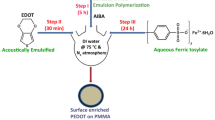Abstract
Selective localization of carbon black (CB) at the interface of polymer blends was achieved by the method that poly(styrene-co-maleic anhydride) (SMA) was first reacted with CB, and then blended with nylon6/polystyrene (PA6/PS). In the PA6/PS blends, CB was localized in PA6 phase and typical double percolation was exhibited. In the PA6/PS/(SMA–CB) blends, TEM results showed that CB particles were induced by SMA to localize at the interface, resulting in the especial interface morphology fabricated by SMA and CB. The especial interface morphology of PA6/PS/(SMA–CB) caused distinct triple percolation behavior and very low percolation threshold. The positive temperature coefficient (PTC) intensity of PA6/PS/(SMA–CB) composites was stronger than that of PA6/PS/CB and the negative temperature coefficient (NTC) effect was eliminated. The elimination of NTC effect was arisen from the especial interface morphology. A stronger PTC intensity was attributed to the low percolation threshold and the morphology.














Similar content being viewed by others
References
Strumpler R, Glatz-Reichenbach J (1999) Conducting polymer composites. J Electroceram 3(4):329–346
Huang JC (2002) Carbon black filled conducting polymers and polymer blends. Adv Polym Technol 21(4):299–313
Sumita M, Sakata K, Hayakawa Y, Asai S, Miyasaka K, Tanemura M (1992) Double percolation effect on the electrical conductivity of conductive particles filled polymer blends. Colloid Polym Sci 270(2):134–139
Zhang MQ, Gang YH, Zeng M, Zhang HB, Hou YH (1998) Two-step percolation in polymer blends filled with carbon black. Macromolecules 31(19):6724–6726
Yui H, Wu GZ, Sano H, Sumita M, Kino K (2006) Morphology and electrical conductivity of injection-molded polypropylene/carbon black composites with addition of high-density polyethylene. Polymer 47(10):3599–3608
Xu ZB, Zhao C, Gu AJ, Fang ZP (2007) Effect of morphology on the electric conductivity of binary polymer blends filled with carbon black. J Appl Polym Sci 106(3):2008–2017
Gubbels F, Jerome R, Teyssie PH, Vanlathem E, Deltour R, Calderone A (1994) Selective localization of carbon black in immiscible polymer blends: a useful tool to design electrical conductive composites. Macromolecules 27(7):1972–1974
Xu SX, Wen M, Li J, Guo SY, Wang M, Du Q (2008) Structure and properties of electrically conducting composites consisting of alternating layers of pure polypropylene and polypropylene with a carbon black filler. Polymer 49(22):4861–4870
Sumita M, Sakata K, Asai S, Miyasaka K, Nakagawa H (1991) Dispersion of fillers and the electrical conductivity of polymer blends filled with carbon black. Polym Bull 25(2):265–271
Gubbels F, Jerome R, Vanlathem E, Deltour R, Blacher S, Brouers F (1998) Kinetic and thermodynamic control of the selective localization of carbon black at the interface of immiscible polymer blends. Chem Mater 10(5):1227–1235
Dai K, Xu XB, Li ZM (2007) Electrically conductive carbon black (CB) filled in situ microfibrillar poly (ethylene terephthalate) (PET)/polyethylene (PE) composite with a selective CB distribution. Polymer 48(3):849–859
Feng J, Chan CM, Li JX (2003) A method to control the dispersion of carbon black in an immiscible polymer blend. Polym Eng Sci 43(5):1058–1063
Al-Saleh MH, Sundararaj U (2008) Nanostructured carbon black filled polypropylene/polystyrene blends containing styrene–butadiene–styrene copolymer: influence of morphology on electrical resistivity. Eur Polym J 44(7):1931–1939
Feng JY, Chan CM (2000) Positive and negative temperature coefficient effects of an alternating copolymer of tetrafluoroethylene–ethylene containing carbon black-filled HDPE particles. Polymer 41:7279–7282
Ahmad A, Mohd DHJ, Abdullah I (2004) Electron beam irradiation of carbon black filled linear low-density polyethylene. J Mater Sci 39(4):1459–1461
Xie HF, Deng PY, Dong LS, Sun JZ (2002) LDPE/carbon black conductive composites: influence of radiation crosslinking on PTC and NTC properties. J Appl Polym Sci 85(13):2742–2749
Lee GJ, Han MG, Chung SC, Suh KD, Im SS (2002) Effect of crosslinking on the positive temperature coefficient stability of carbon black-filled HDPE/ethylene–ethylacrylate copolymer blend system. Polym Eng Sci 42(8):1740–1747
Bin Y, Xu C, Zhu D, Matsuo M (2002) Electrical properties of polyethylene and carbon black particle blends prepared by gelation/crystallization from solution. Carbon 40(2):195–199
Xi Y, Ishikawa H, Bin YZ, Matsuo M (2004) Positive temperature coefficient effect of LMWPE–UHMWPE blends filled with short carbon fibers. Carbon 42:1699–1706
Feng JY, Chan CM (2000) Double positive temperature coefficient effects of carbon black-filled polymer blends containing two semicrystalline polymers. Polymer 41(12):4559–4565
Wang GJ, Qu ZH, Guo JL, Li Y, Liu L (2006) Study of multiple-wall carbon nanotubes functionalized by the poly(styrene-co-maleic anhydride). Acta Chim Sin 64(24):2505–2509
Meyer J (1973) Glass transition temperature as a guide to selection of polymers suitable for PTC materials. Polym Eng Sci 13:462–486
Ohe K, Naito Y (1971) A new resistor having an anomalously large positive temperature coefficient. Jpn J Appl Phys 10:99–108
Voet A (1981) Temperature effect of electrical resistivity of carbon black filled polymers. Rubber Chem Technol 54:42–50
Acknowledgments
The authors gratefully acknowledge the financial support of this study by the National Natural Science Foundation of China (Contract Number: 51003024) and the Foundation for University Young Key Teacher of He’ Nan Province.
Author information
Authors and Affiliations
Corresponding author
Rights and permissions
About this article
Cite this article
Lu, C., Hu, Xn., He, Yx. et al. Triple percolation behavior and positive temperature coefficient effect of conductive polymer composites with especial interface morphology. Polym. Bull. 68, 2071–2087 (2012). https://doi.org/10.1007/s00289-012-0723-0
Received:
Revised:
Accepted:
Published:
Issue Date:
DOI: https://doi.org/10.1007/s00289-012-0723-0




